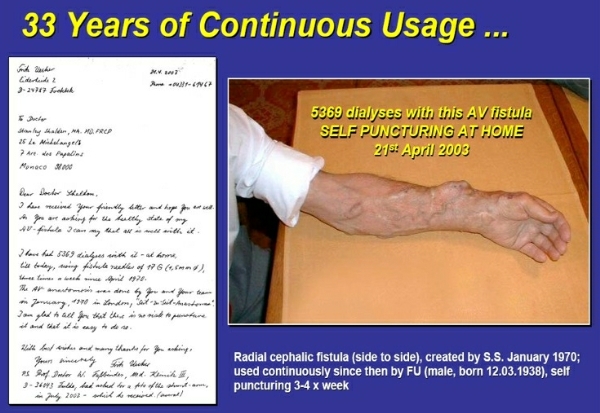The recent accidental death of Belding Scribner on June 19th 2003 has highlighted the old adage that precedent claims are rarely correct. (Fig 1)
Figure 1
The original idea of a bypass to maintain the patency of indwelling arterial and venous catheters was developed by Nils Alwall in 1948 and published in 19491. In his first animal experiments in rabbits, the carotid artery and jugular vein were cannulated with siliconised glass tubes and patency was maintained with a curved siliconised glass capillary bypass. Following the success of the animal work, Alwall started treating patients with end stage renal disease2. However, because of local infection and clotting he abandoned the technique in 1949. (Fig 2)
Figure 2
Thus, the real merit of Scribner's contribution (who recognized Alwall's original claim in the first publication in 1960 at ASAIO3) was his determination not to abandon the technique. This intense determination to succeed was evident in his presentation at Evian in September 1960 which I had the honour to hear4. Alwall also gave a presentation at Evian on the Swedish experience in long term dialysis 5 and as a consequence of their work, I started a long term ESRD dialysis program at the Royal Free Hospital London in 1961.(Fig 3)
Figure 3
At this time, the Teflon shunt had a life expectancy of weeks and for this reason we developed a femoral vessel puncture technique with a modified Seldinger catheter 6(Fig4).
Figure 4
Attempts at leaving the catheter in permanently were soon abandoned after fatal embolic and infectious complications 7 and we switched to the shunt developed by Quinton in 1961 where he had developed a flexible siliconised rubber tube to replace the original all Teflon shunt 8. The silicone Teflon Quinton shunt had a life expectancy of months to years and without this development it is unlikely that there would be more than one million people today living on dialysis. (Fig 5)
Figure 5
However, in my opinion, the definitive access site had to await the development from New York by Cimino and Brescia working at the VA hospital in the Bronx. In 1962 9, they had attempted to perform regular dialysis with a simple venipuncture and pointed out the advantages of this technique over the indwelling Scribner shunt or our repeated femoral vessel puncture technique. It only required the contribution of Appel, the surgeon of the group to construct the AV fistula for their argumentation of 1962 to become a reality 4 years later10. Today, I have no doubt that the only acceptable long term approach to haemodialysis is via a venipuncture of a fistularised vein resulting from a surgically created arteriovenous. (Fig6)
Figure 6
My personal anectodal belief is based upon 33 ½ year survival of a radio cephalic fistula I created in January 1970, that has been punctured more than 5300 times by the patient himself (3-4 x week) (Fig 7).
Figure 7
Today, I have no doubt that the only acceptable long term approach to haemodialysis is via a venipuncture of a fistularised vein resulting from a surgically created arteriovenous fistula.
Stanley Shaldon
Monaco
1st October 2003
References
1.Alwall N, Bergsten B, Gedda P, Norvitt L and Steins AM. On the artificial Kidney IV. The technique in animal experiments Acta med. Scand 132: 392 1949.
2. Alwall N, Norvitt L, and Steins AM. the artificial Kidney VII Clinical experiences of dialytic treatment of uraemia. Acta med. Scand 132: 587 1949.
3. Quinton W, Dillard D, Scribner BH Cannulation of blood vessels for prolonged hemodialysis .
Trans .Amer.Soc. Artificial Internal.Organs 6, 104-109 1960
4. Scribner BH. Continuous hemodialysis as a method of preventing uremia in chronic renal failure. Proceedings of 1st International Congress of Nephrology Evian 1960
5. Alwall N. Fifteen hundred treatments with the artificial kidney (Dialysis, ultrafiltration) 1946-1960. Proceedings of 1st International Congress of Nephrology Evian 1960.
6. Shaldon S, Chiandussi L and Higgs B, Haemodialysis by percutaneous catheterization of the femoral artery and vein with regional heparinisation. Lancet 2: 857-859 1961
7.Shaldon S, Baillod R, Compty C, Oakley J, Sevitt L. Eighteen Months experience with a nurse patient operated chronic dialysis unit. Proc.Europ Dialysis Transpl Ass. 1: 233-242 1964.
8 Quinton WE, Dillard DH, Cole JJ and Scribner BH Eight months experience with Silastic-Teflon Bypass Cannulas. Trans .Amer.Soc. Artificial Internal.Organs 7;236-243 1962
9. Cimino JE and Brescia JB Simple venipuncture for hemodialysis. New Engl. J. Med 267 608-609 1962.
10. Cimino JE, Brescia JB , Appel K and Hurwich BH. Chronic hemodialysis using venipuncture and a surgically created arteriovenous fistula. New Engl.J.Med 1966 275 1089






